by Briscoe White | Jan 19, 2011 | Containers, Gardening, Growing, Herbs, Indoor Gardening, Miscellaneous, Urban Gardening |
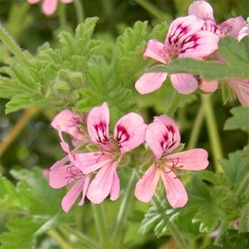
There are over 200 variations of Pelargonium, each with a specific scent and beauty.
Oh Scented Geraniums, so lovely, so fragrant, so easy to grow, so…not even geraniums at all! Scented Geraniums are not considered “true” geraniums and are of the genus Pelargonium, but their leaves do resemble geraniums and they share the same botanical family. Their success as portable container plants make them favorites in almost any climate, both inside and out. Scented Geraniums are native to South Africa, but became hugely popular with Europeans in the early 16th century. Thomas Jefferson was known to grow several varieties at the White House, and here at The Growers Exchange, we sell three of our favorite varieties: Citronella, Old Fashioned Rose, and Atomic Snowflake.
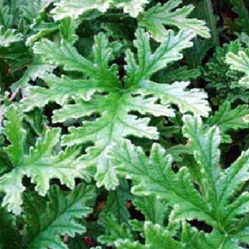
The sweet Citronella fragrance comes from the plant's foliage, not its blooms.
Citronella is probably the most well-known, due to its use as a safe and natural insect repellent. Oil from this plant is commonly extracted from the plants and added to home-made and over-the-counter products. Many gardeners also plant bushes of Citronella in their gardens, and simply swipe the mass with a broom to bruise the foliage, which releases the plant’s fragrant, citrusy aromas. Though it’s sometimes debated whether this actually works effectively as a repellent, when planted in large quantities, we’ve noticed a significant decrease in mosquitoes around our patio on warm summer evenings. We’ve also found that the lemon and rose varieties are the best for container planting. They will grow compactly but a little goes a long way! Their perfume will freshen your patio or home as long as you keep it nice and happy with plenty of sun and adequate watering.
Great in the garden but also quite content in a hanging container or pot, be sure to provide well-drained soil, and not to over-fertilize. It is actually better to under-fertilize than over-fertilize these aromatic beauties, as soil excessively rich in nutrients (especially Nitrogen) can cause leaves to be less fragrant. Fertilize from spring through fall for best results, and fight the urge to fertilize during the winter. This is when the herb naturally slows down production, and fertilizing at this point may trick it into a false growing period, which will result in less than favorable bloom and fragrance production.
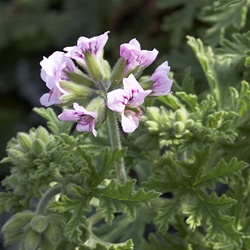
Clusters of sparse blooms are a defining characteristic of the Pelargonium.
Thriving in bright light, be sure to place them in a southern-facing window with ample mid-day sunlight if growing indoors. Preferring daytime temps around 70 degrees, these continuous bloomers will flower until the first frost. Overall, scented geraniums are quite drought-tolerant and therefore relatively easy to grow plants. Do not allow them to completely dry out before waterings, but at the same time be sure not to over-water, as constantly saturated soil can cause root rot problems. Clay pots help gardeners who tend to get a bit water-happy, as they allow excess water to seep out through the porous clay. Moisten only the soil when needed, rather than watering the whole plant, to ensure that it gets just enough water without drowning.
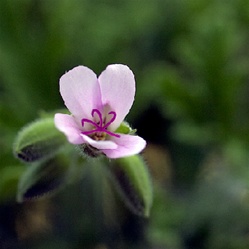
Though they vary in shape, size and color, every variety shares the same five-petaled bloom design.
Prune in early spring for fuller blooms and foliage. Cut right above the node with clean, sharp shears. Pinching and pruning redirects the plant’s energy back into the remaining stem, forcing it to sprout new, thicker, fuller growth. Early spring pinching takes advantage of the plant’s natural growing season, allowing the plant plenty of time to grow before its natural slower-growing-months of winter. They are also a popular bonsai plant and can be pruned and trained to resemble a more fragrant replica of a bonsai tree.
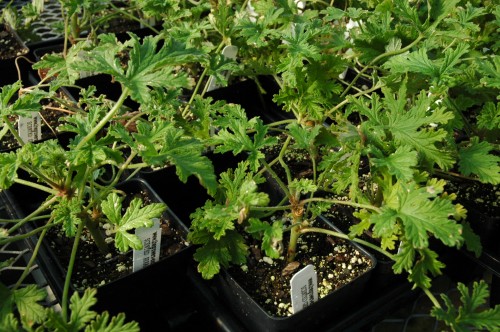
Growing Scented Geraniums is easy if you give them lots of sun and adequate water.
Scented Geraniums can be germinated from seeds or propagated from stem cuttings. When growing from seed, they typically germinate quickly, sprouting in a mere few days to a few weeks. Keep the seedlings out of direct sunlight as they will not grow if the soil is warmer than 75 degrees. From trial and error, it seems that plants started from seed rather than propagation tend to be stronger, and resist disease and cold temperatures better. After planting, you should see blooms twelve to sixteen weeks after the seeds are sown. If propagating from cuttings, make sure to start in early fall, and to cut four to six inches from a healthy, mature plant just below where leaves or nodes are growing. Taking a large enough cutting, typically containing three to four leaves, should be a big enough piece that should stand any stress from the transplanting process. Also, once the new plant has established a root anchor and is beginning to mature, be wary when pruning. Pinch the growth tips back by mid-February or the beautiful blooming clusters will be postponed in flowering.
by Briscoe White | Jan 18, 2011 | Containers, Gardening, Growing, Herbs, Indoor Gardening, Miscellaneous, Recipes |
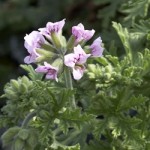
Citronella Scented Geranium
Long-loved for their intense fragrances that range from fruity and floral, to earthy and spicy, Scented Geraniums, or Pelargoniums are an amazingly aromatic ornamental and culinary herb. Cousin to the garden-variety red “grandma’s Geranium” seen so often growing in window boxes and flower beds across the South, Pelargoniums are in the same family and though they share the name, are not “true” Geraniums. First discovered in the 1600’s in South Africa, Pelargoniums were originally lumped in with Geraniums because of their resemblance and similar habit, but as their popularity rose and botany progressed, their taxonomy changed and they were given their own distinction. They received the name, Pelargonium to define them separately, which is derived from the Greek word for “stork”, as part of the bloom seems similar to a stork’s bill.
Reaching the height of their vogue in the Victorian Era, Scented Geraniums were cultivated in greenhouses throughout Europe for the herb’s numerous rich aromas, until fuel had to be reallocated to war efforts, which left enthusiasts unable to heat their greenhouses. With over two hundred varieties of this lovely, fragrant herb, it’s no surprise that they remain a favorite garden, patio and culinary herb for today’s gardeners. The biggest bonus of the Pelargonium is its intensely scented foliage. Depending on the variety, the leaves may be dainty and lacy, rounded or sharply defined, and come in many different verdant hues from light to dark green, including some species with cream or golden variegation on its fringes. Typically, the plant’s blooms have little to no smell, leaving the leaves with the bulk of the herb’s fragrance. Just as with their leaves, depending on the type of Pelargonium, blossoms may come in a variety of colors, patterns and shapes. Generally they all share the same five-petaled design, offering gardeners the option between pink, purple, white, red and yellow hues, masked centers, and wide or thin blooms. (Some even resembling miniature Orchids!)
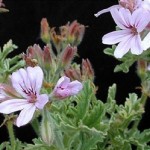
Rose Scented Geranium
In the kitchen, these herbs infuse desserts and other dishes with their scent, and delicately translate their perfumes to our taste buds. Pairing well with fruits like apples, melons and bananas, scents like Rose or Lemon really enhance the flavor of the meal. Try adding some of the Lemon or Peppermint leaves, wholly, to your next iced tea. You can also line the bottom of your cake pans when baking, with Scented Geranium leaves to infuse your favorite cake with a natural flavor. Also used to make syrups, jellies, liqueurs, and flavored butters, Scented Geraniums are a deliciously versatile herb.
Pelargoniums have also long been believed to possess magical and spiritual powers, usually dependent upon the scent or color. Thought to be a good luck charm for healthy, love, protection and powerful in repelling evil and negativity, Scented Geraniums were (and continue to be) used in bath infusions, perfumes, herb pillows and protective sachets. Though used solely in these functions for their fragrance in modern days, superstitions tied to specific scents still linger. It was once believed that Nutmeg Scented Geraniums would bring someone financial good fortune, while Rose Scented varieties would bring a healthy love life. Beliefs were also based on the color of the blooms, such as White Pelargoniums were a symbol of fertility, while Red strains meant strength and protection.
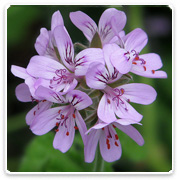
Atomic Snowflake Scented Geranium
Also used in arts and crafts like wreath and potpourri-making because of their long lasting fragrant leaves, Scented Geraniums are like nature’s little air fresheners! Fill your home with citrus and floral scents the natural way and stop using costly, chemical-based candles (plants won’t accidentally burn your house down!) and plug-ins. Lemon and Rose scents tend to grow ideally in containers and make great houseplants. Place them in a sunny window or in a high traffic area–brushing past the scented leaves will release each plant’s specific aroma and will revitalize your senses, especially after a long day. You can also place the leaves in your pillow case or dresser drawer. This will not only repel moths but perfume your laundry and soothe you as you sleep.
Three of our favorite varieties of Scented Geranium are the Citronella, Rose and new this year, the Atomic Snowflake! Each offers a distinct scent and beauty that performs well in the kitchen or garden and is ideal for container growing in or outdoors on patios and windowsills. We love making scented sugar for baking by alternating granulated sugar and Rose Pelargonium leaves, sealing the layers in a jar and leaving it in a sunny window for two weeks. This infuses the sugar with the delicate aroma of fresh cut roses and tastes delicious on cakes and cookies! If grown in high quantity, the Citronella variety is said to repel mosquitoes. Debated in the scientific and gardening communities as to its results, we love its citrusy smell—it reminds us of warm summer evenings. Last and certainly not least, our newest and one of the most beautiful breeds, is the Atomic Snowflake. The name alone brings excitement to mind and its hybrid scent of floral and fruity tones will make a great culinary garnish and a potent perfume for your home or garden!
by Briscoe White | Jan 17, 2011 | Containers, Gardening, Growing, Herbs, Indoor Gardening, Miscellaneous, Urban Gardening |
When talking about Rosemary, my mind immediately wanders to the kitchen. That savory piney smell that wafts out from under pot lids, or from a steaming roast or loaf of bread just out of the oven. One of the most basic culinary herbs, Rosemary has remained popular for many reasons since its early use in Greek and Roman cultures where it was used for everything from repelling evil and sickness to symbolizing fidelity between lovers. Though long believed that if grown in kitchen gardens, Rosemary represented the strength of the matriarch of the home, in modern times Rosemary has lost its gender bias and is a culinary herb enjoyed by all. A member of the Mint family, Rosemary is a cousin to Basil, Oregano and Lavender, which explains why they grow and taste so great together! Yet, one of the best reasons to love Rosemary is its ability to grow in many different climates and zones and for its versatile usage and easy care. To give you an idea of what we mean, here’s a crash course in Rosemary!
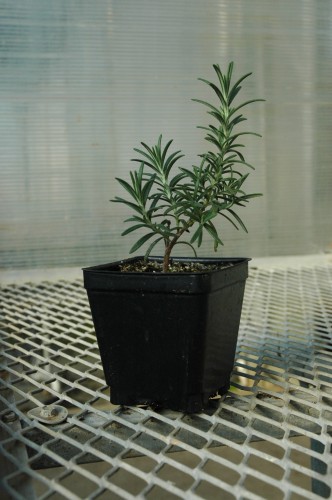
By far the most cold-hardy variety, ‘Arp’ has thin, silvery, needle-like leaves. It’s the plant’s uniquely sized foliage that I believe makes it so temperature-tough, as with less surface area the plant is able to conserve its energy and essentially becomes impenetrable to cold weather. Aromatic and easy to grow, this variety is great because it gives chefs who live in more northern zones, like Zone Six, a delicious culinary option when other herbs can’t survive. Also quite drought resistant, try planting Rosemary ‘Arp’ as a low-growing hedgerow. Brushing past it will release its wonderful scent.
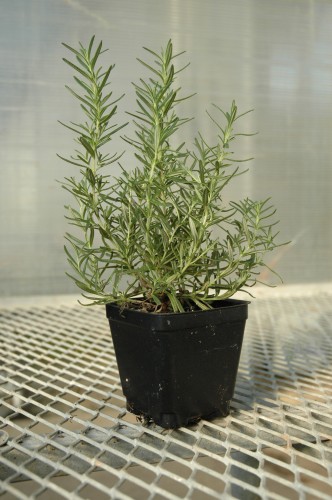
Typical of the traditional Rosemary foliage, ‘Hardy Hill’ is the second most cold tolerant variety and produces characteristic dark green, needle-like foliage. A terrific culinary herb, ‘Hardy Hill’ will survive in cold areas as low as Zone Seven and is drought tolerant. Great on potatoes, in stews and breads, or to season meats, ‘Hardy Hill’ really comes through when the temperatures are low. Similar to Rosemary ‘Arp’, yet possessing a darker color, ‘Hardy Hill’ grows well in containers as well as in your garden, and can be grown indoors during extremely cold temperatures.
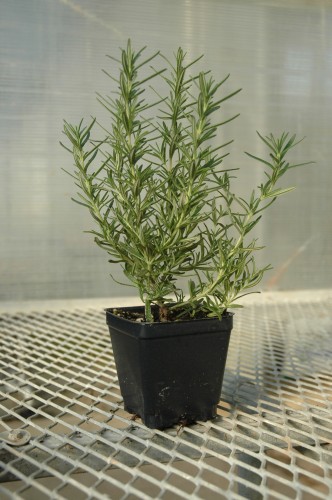
Very similar in habit and look as ‘Hardy Hill’, without the extreme hardiness. ‘Salem’ is a more cold sensitive variety of Rosemary but is more useful in the kitchen. Not only can you use its flavorful foliage to lend a savory distinction to your favorite dish, but you can use its woody branches for barbecue skewers. We actually tried this over the summer when we had lamb kabobs. The natural fragrance and flavor of the Rosemary infused the meat as it cooked over the grill, releasing tons of taste and perfuming the air. Give this a shot the next time you’re grilling pork, lamb or beef. If you don’t feel like making skewers, try sinking the sticks into the full piece of meat to really cook the amazing aroma into your dish. Perennial in Zone Seven through Zone Ten, ‘Salem’ has light, almost smoky green foliage.
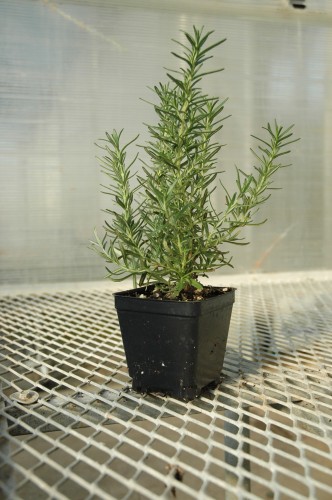
By far the most beautiful of the Rosemary varieties we grow! ‘Tuscan ‘Blue’ produces tons of beautiful blue flowers and lush foliage, making this variety the ideal Rosemary for topiaries. As useful in the kitchen as it is beautiful in the garden, ‘Tuscan Blue’ is used to flavor dishes in many of the same ways as its hardier cousins. Also a terrific indoor herb because of its lovely fragrance and glossy, dark green leaves, ‘Tuscan Blue’ has an erect habit and grows best in Zone Eight through Zone Ten. It’s sometimes best to container plant this delicate beauty for moving indoors, as even cool evening temperatures may upset it.
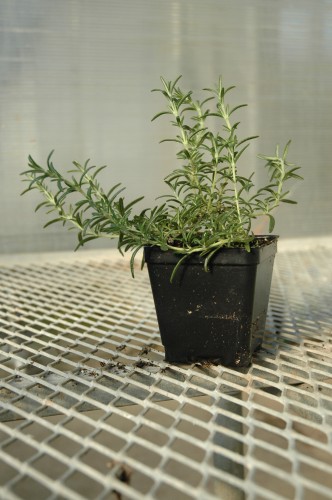
A great ground cover Rosemary, ‘Prostrate’ is not terribly hardy, but where it’s warm enough, this great variety won’t let you down. A landscaper’s dream, ‘Prostrate’ can be planted as a stand alone landscaping shrub, so it doesn’t take up room in your garden. Fashionable and functional, just make sure to plant it in close proximity to your kitchen for easy use. This great dual purpose Rosemary will brighten your yard and your kitchen without using valuable garden space. Try planting this along a garden wall or in a large planter and let it spill over the edge to create a culinary cascade!
Regardless of which Rosemary you prefer, they all have terrific culinary and aromatic value. Planting them in your garden or keeping them indoors will provide you with a delicious herb for your favorite recipes as well as a wonderful fresh fragrance that can’t be matched. Try using your favorite Rosemary variety in wreaths, potpourris, or as centerpieces. By adding Rosemary to a mesh sachet, you can place it in your bath for a soothing soak or in your drawer to freshen up your laundry. You can even extract the oils and use it as an all natural perfume that will actually condition your skin! We love working with this versatile herb in the greenhouse, as we always leave smelling of its sweet, piney scent. The possibilities for using Rosemary are endless! No matter what zone you live in, we have a Rosemary for you, so don’t be discouraged by your location!
by Briscoe White | Jan 13, 2011 | Gardening, Growing, Herbs, Miscellaneous |
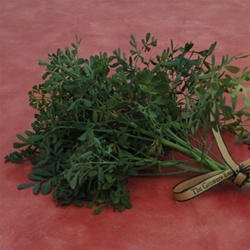
As The Growers Exchange has evolved, herb plants have become our main focus. The wonder of the internet has allowed us to understand what plants people are searching for, so we have tailored our crop to match this demand. Having an “ Herb Plants for Sale” sign on the internet means we get all kinds of requests… Each is a story unto itself so I have to focus on one at a time! This is the story of how we discovered Rue…
Rue is an herb that now has a large presence in our nursery. One day we received a call from a man looking for fresh cut Rue. We sell Rue plants in four inch pots, but we did not have anywhere near enough plants for cutting. After a discussion, he visited the farm while in the area, and we quickly bought a large pack of Rue seed soon after he left. That spring we planted two thousand plants in our orchard, and by late summer we were shipping twenty-five pounds a week to New York City. Our customer is co-owner if the largest botanica on the East Coast. What’s a “botanica” you may ask? We didn’t know either, so I better explain that a botanica caters to people with beliefs that require many natural products not easy to find in a city. People come from near and far to fill their wish list.
Rue is in high demand and we now have thousands of plants in our field, and we ship Cut Rue in lots of one hundred pounds to NYC. I have told the story of how Rue’s phyto-photo toxicity caused second degree burns on several of our workers that mistakenly touched the plant in sunlight, without protective gloves, in our previous blogs. (For a refresher course on how to use Rue, read our latest blogs in Briscoe’s Seeds For Thought.) Jason Mizrahi, co-owner of Original Products buys most of our Cut Rue. I asked him what all the Rue was used for and he explained Rue is used in several ethnic dishes and was used for many medicinal and spiritual purposes. The herb is also thought to bring good luck and prosperity to those that ingest it.
This is good news for us! Though none of us here at The Growers Exchange plan to ever eat or even touch Rue without gloves; we do like growing Rue as a crop. Our Rue field has to be one of the largest anywhere. We find the challenge of growing many different plants fun; we have other unusually large quantities of various other herbs for other special use customers, but none in the quantity we grow Rue. Who knew about Rue?
by Briscoe White | Jan 12, 2011 | Gardening, Growing, Herbs |

Rue is a beautiful, aromatic perennial herb with many culinary and medicinal uses. Hardy from zone 4 to 9, Rue thrives with little care and grows in a shrubby habit. It enjoys hot, dry climates, and poor, sandy, even rocky soil, and proves to be pretty drought-resistant when established. Great in rock gardens and areas where little else will sprout, this beautiful and practical herb has a rich history and is a cinch to grow!
Rue can be started from seeds and usually germinates in one to four weeks. Rue seeds need light to germinate; be sure to surface-sow your seeds before setting them in a warm, sunny area. Seeds can typically be sown at sixty-eight degrees Fahrenheit for topical germination. Check out our seedlings and young rue plants below! (more…)















